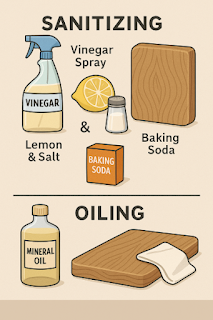Properly Sanitizing and Oiling Wooden Cutting Boards: Natural Methods and What to Avoid
Cutting boards are essential kitchen tools used daily, but many people overlook proper hygiene and maintenance—especially with wooden boards. Poor maintenance can lead to bacterial growth, foul odors, warping, and cracks. That’s why regular sanitizing and oiling are crucial. In this post, we’ll explore effective natural cleaning methods, proper oiling techniques, and common mistakes to avoid when caring for your wooden cutting board.
How Often Should You Sanitize Your Cutting Board?
Because cutting boards absorb moisture and food particles during use—especially when cutting protein-rich items like meat or fish—sanitizing them regularly is vital. Here's a general maintenance schedule:
- Daily: Wash with mild soap and warm water, then dry immediately.
- Weekly: Disinfect with natural agents like vinegar or lemon with salt.
- Monthly: Deodorize using baking soda.
3 Natural Sanitizing Methods
1. Vinegar Spray
Mix white vinegar and water in a 1:1 ratio in a spray bottle. Spray evenly, let sit for 10 minutes, then wipe clean.
2. Lemon & Salt Scrub
Sprinkle coarse salt on the board and rub with a halved lemon. It both disinfects and neutralizes odors.
3. Baking Soda Paste
Sprinkle baking soda onto the surface, lightly wet with water to form a paste, leave for 15 minutes, then rinse.
Why Oiling Your Board Matters
Wooden cutting boards absorb water over time, causing warping and cracks. Oiling creates a moisture barrier that keeps the board protected and extends its life. End grain boards are especially porous and require more frequent oiling.
How to Oil Your Cutting Board
- Recommended Oils: Food-grade mineral oil, or a mix of mineral oil and beeswax.
- Application: Generously apply oil and spread with a cloth. Let absorb for 2–3 hours.
- Finish: Wipe off excess oil and let air-dry in a ventilated area for a full day.
Things You Should Never Do
- 1. Never put your board in the dishwasher: The heat and pressure can warp or break glued joints.
- 2. Avoid bleach: It can soak into the wood and leave chemical residues.
- 3. Don’t soak in water: Prolonged exposure swells the wood fibers, causing cracks.
Storage Matters Too
Always store your cutting board upright to allow proper air circulation. Avoid humid places and opt for a board stand or a wall-mounted rack.
Conclusion: With Proper Care, Your Board Will Last Years
With regular cleaning and oiling, a quality wooden cutting board can last for many years. Because you use it every day, good hygiene habits make a difference—not just for your cooking tools but also for your health. Take a few minutes each week to care for your board, and it will repay you with longevity and safety.



